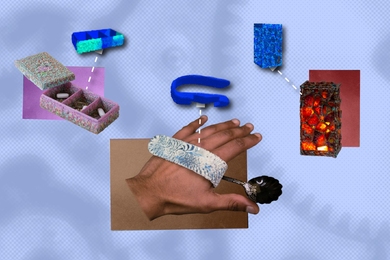For more than a decade scientists have been working to explain how infectious agents called prions cause certain neurodegenerative diseases in humans and in some animals.
Now MIT scientists and colleagues have taken an important step toward solving the mystery by replicating part of the disease process in a test tube.
Among other things, the work could lead to a test for whether prion diseases can be transmitted between species. That issue is of particular interest in England, where an outbreak of "mad cow disease" has fueled concerns over whether the disease can be transmitted to people who eat beef.
The prion is an unusual protein that exists in two different forms: one of these forms is a common brain protein, while the other spells disease. And in the molecular equivalent of a bad apple, the normal protein can turn into the infectious version when exposed to its abnormal counterpart.
The MIT and NIH researchers demonstrated that conversion in a test tube.
"We took the good stuff and converted it to the bad stuff outside of the cell. That's never been done before," said Dr. Peter T. Lansbury, associate professor of chemistry and co-author of a paper on the work, published in an August issue of Nature. Other MIT authors are Graduate Students David A. Kocisko and Jon H. Come of chemistry.
Because the scientists' test-tube concoction contained no cellular material, the work "demonstrates that the prion protein alone can work this conversion," Professor Lansbury said. That distinction is important: many scientists have argued that some co-factor associated with the abnormal protein, such as a virus or some undiscovered genetic material, is actually causing the disease-not the prion alone.
"The new research greatly reduces the possibility" that a co-factor causes prion diseases, wrote Sandra Blakeslee of the New York Times. Earlier tests used prions that were in a less purified form, so "it was difficult to prove that a more conventional infectious agent was not involved," she said.
Nevertheless, to prove conclusively the "protein-only" theory, the scientists must first put the abnormal prions created in the test tube back into a living animal to see if they do indeed cause disease. The team is now working to do so by modifying parts of the procedure, Professor Lansbury said.
The new work could lead to a test to determine whether mad-cow disease is transmissible to humans. In such a test researchers would expose healthy human prions to abnormal cow prions and observe the results.
Further, with the ability to replicate prion conversion in a test tube, Professor Lansbury said, "we can now study the mechanism of conversion in detail." This will result in a better understanding of prion diseases, which in humans include kuru and fatal familial insomnia.
The prion work could also aid research in Alzheimer's disease. Professor Lansbury, who has worked on Alzheimer's for six years, explained that the two groups of diseases resemble each other in a variety of ways. For example Alzheimer's, too, is believed to begin when a "normal" protein is converted to an abnormal form.
The work was sponsored by the NSF through a Presidential Young Investigator award to Professor Lansbury and by the NIH.
A version of this article appeared in the September 14, 1994 issue of MIT Tech Talk (Volume 39, Number 4).





